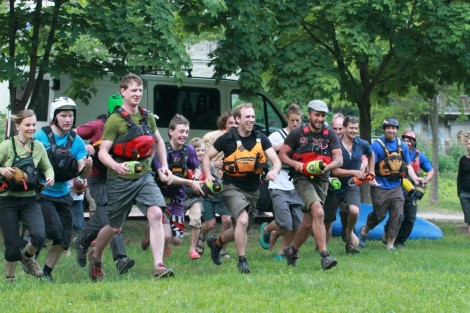This months coaching dispatches will looks at eddy turns coming from the flow into calmer water.
We want to ensure that we can perform a wide eddy turn to get ourselves across a thick eddy line, to get ourselves safely at the bank and to not block the entrance to the eddy for the next person. Your friends won’t take too kindly to you being in the way at that must make eddy above the portage! In a nut shell I think there are 3 key things to bear in mind.
We must think ahead and plan. Our history of travel or momentum must be towards the eddy (blue line) and not downstream, hence traveling laterally across the river into the eddy (green line). This will prevent bouncing off the eddy line and carrying on down river (red line). The sketch below shows this history of travel.
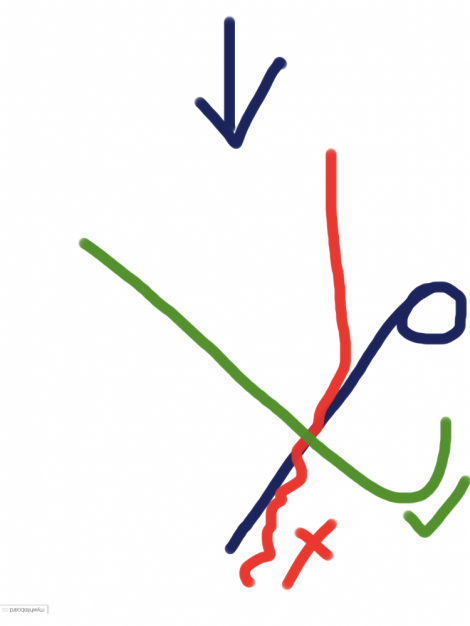
As we cross the eddy line we need to ensure the boat is not knocked off line by the eddy line whilst keeping the kayak as flat as possible. Edging the boat now will only encourage the boat to turn super fast and spin on the spot and not penetrate into the eddy. There is also a difference between holding the kayak on line and performing a sweep stroke at the end line which again encourages the boat to spin on the eddy line.
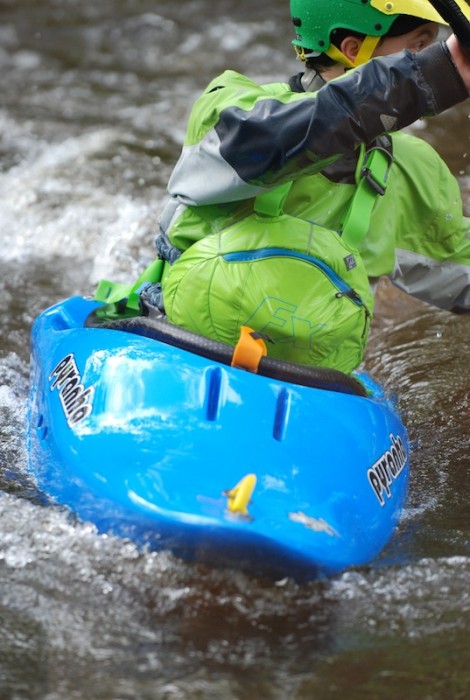
As the boat starts to turn upstream, a forward paddle stroke on the inside of the turn will lengthen the turn further and give you support. You can follow this stroke on into a stern squeeze to control the end of the turn.
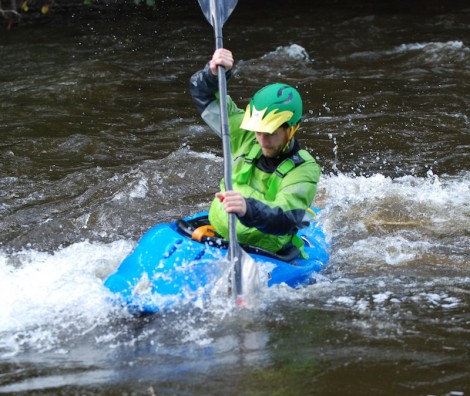
Good posture throughout is key, as the strength for your forward strokes, balance during the turbulence of the eddy line and your control of the stern squeeze comes from your core. Practice and varied environments is needed for robust skills but these ideas are a pathway to perfect eddy turns.
This months coaching dispatches will look at activity posture. Good posture is undoubtedly the key to whitewater kayaking. Without it, it’s so difficult to keep your balance or take good effective paddle strokes, both fundamental!

Here I am sat right into the back of the seat, sat upright and then leaning slightly forwards from my hips, careful not to hutch over, moving my centre of gravity just past my seat towards the bow of the kayak.
Although it’s easy to have the correct posture on flat water it can be harder to maintain this posture if your core strength is a little weak. Any core exercise such as the plank help but the strength will build with time in a boat, therefore you might notice good posture at the beginning of the day but it becomes worse over time.
It’s a lot harder to maintain this posture when the river becomes 3D and you are running drops and slides or when the boat is accelerating.
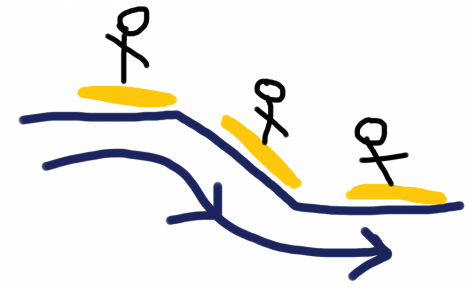
This sketch shows what happens when you don’t anticipate this change in environment. You’ll notice that the paddler doesn’t actually lean back but the boat moves relative to the slide without the paddler, when the kayak straights up at the bottom the paddler is leaning back.
We must anticipate the white water and actively move our posture forwards so its stay forwards relative to the boat. The main difference to spot, although there are others, is that as the sketch paddler reaches the bottom, they have good posture for the unstable water, such as a stopper, so therefore you have your balance and can take effective strokes away.
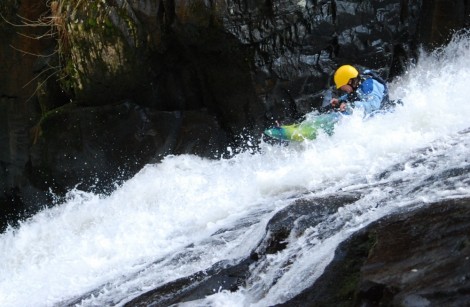
Here you can see a student on a steep creekin’ course in Wales working on her activity posture. She is moving her whole body forwards to anticipate the stopper at the bottom and below we can see Palm Team paddler Tom Parker showing great posture on holiday in Switzerland.

This weekend I’ll be running a free clinic at Gene17 Rivers Source Event themed around posture, it’s that much of a big deal!
I’ve been paddling in the Spark suit since heading out to Italy in May and have been surprised by how good it is. I was therefore, really excited to be able to get my hands on the new Torrent suit a few weeks ago.
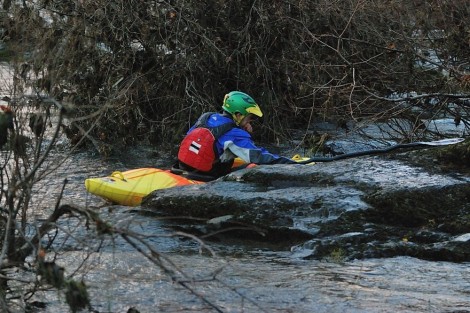
The suit is keeping me warm & dry but nothing I can do for my hands!
I’ve been running white water safety and rescue courses virtually none stop since getting hold of this sample suit and it’s stood up to my demands of the job incredibly well.
I’ve remained completely dry whilst jumping in and out of stoppers and lying in the water pretending to be injured for prolonged periods of time.
The material shows no signs of wear despite having been dragged over rocks, bushes and gravel (still pretending to be injured in the scenarios), so I think it’s going to be really durable.
I’ve noticed the new sock design is making it easier to put on my shoes and feels less bulky once on, which is a sweet improvement too.
The safety courses also have a paddling element and once on the water, the cut of the suit, the positioning and flexibility of the zip are the most notable improvements from the last generation of Torrent suits. If you try one on in the shops, you’ll notice the freedom.

#moretosafetyandrescuethanjustswimming
This freedom of movement in this suit is great.
I also hear it will be available at your local dealer come the start of December, good news given the cold weather and heavy rain that is due!
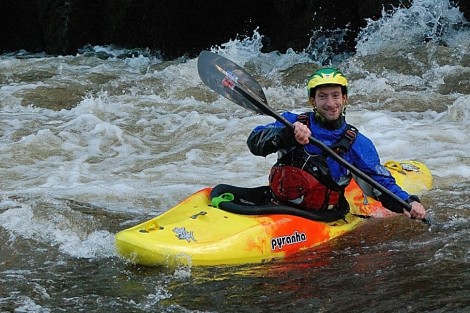
Great lines, happy times.
As winter draws in, kayakers from across the UK gather in the North East on the banks of the River Tyne to dance, socialise and paddle.
And with so many kayakers in one place, Rowie & I took a load of demo boats and examples of shinny new Palm kit to show off!
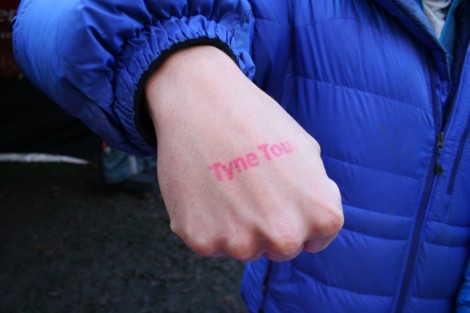
The event has a simple and effective format.
Friday, friends arrive in drips and drabs from far flung parts of England, Scotland & Wales and arrive in the pub to catch up.
Saturday, paddle the Tyne Gorge. With over 800 paddlers spread across the length of the river, you are constantly bumping into friendly faces and looking out for each other. Great fun. With the Palm/Dagger stand at the take out to the river, which is also the campsite, we were on hand all afternoon to chat about the new Stikine and Torrent drysuits and FX PFDs. The stand hosted stubbies and stories in the early evening, giving people the opportunity to share their expedition stories, hear some of ours and plan their next.
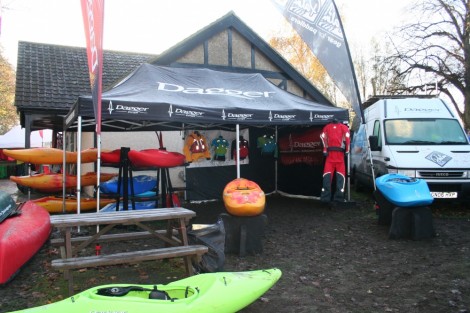
The Stand at 8am
Later, it’s the party. After warming up and having some food it’s off to the local sports hall. The Ceilidh band lead the evenings activities in song and dance. With each tune, the steps are explained and away you go.
Sunday, the aftermath. The combination of a second night of cold camping and too much drinking gives a slow start to sunday morning. Some people head for another lap of the Tyne, others off to the steeper River Tess and the rest hang out in the field moaning about the cold, drinking tea and such.
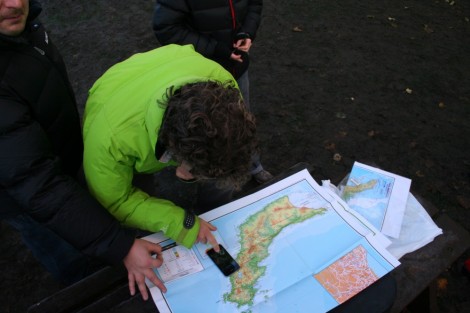
Planning
Thanks to the organisers for a great event and Hexham town for the fireworks and hosting us!
Choosing what to pack on expeditions can be tricky, often limited by space and weight, meaning the things you take must be multi-purpose. This has never been so much the case than on my recent trip to the Outer Hebrides.
The islands are off the west coast of northern Scotland and a 5 hour ferry from the town of Oban. The chain of islands extends for 210km, most of them being uninhabited. Our target was to sea kayak around the southern tip and base ourselves on the islands to do some multi-pitch sea cliff climbing.
With a perfect weather window, the trip was a total success. The highlights being paddling in the 3m gap formed between the mainland and Liànamuil island in an exciting swell, a four way arch, multi-pitch abseiling and seeing lots of cool wildlife including puffins, seals, eagles and basking sharks.

Narrow Gap at Barra Head
The front hatches of our sea boats were filled with climbing gear leaving limited space for 7 days’ worth of food, something to sleep in and on, and some spare clothes. The only shoes I had were my Palm Gradients and were used with great comfort to paddle over 30km twice in consecutive days and on other days walk and scramble across the islands accessing the crags. I was so impressed with these in the mountainous terrain that I plan to use them again next time I head into the hills at home in North Wales. Their grip,
support and comfort over long distances is as good as any mountain boot.
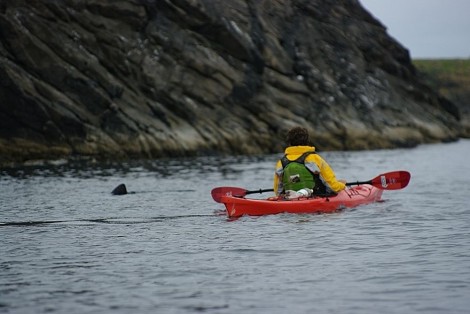
A Bashing Shark.
My Oceana jacket was comfortable over the long paddling distances, a pleasure to use but also kept the wind off me whilst cooking dinner at base camp on the cooler evenings, again multi-purpose as it was the only windproof (& water proof) layer I had taken with me!
I can’t describe the extent to which I enjoy overnighting from a kayak. It’s hard to do within the UK in a white water context, but we have one of the best coastlines in the world so why not enjoy it!
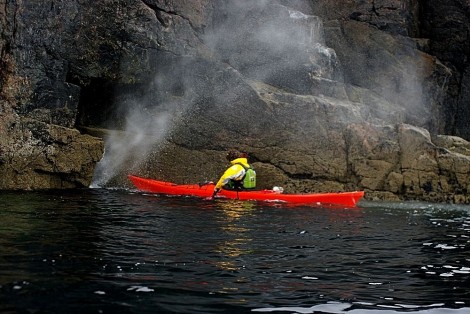
A Blow Hole!
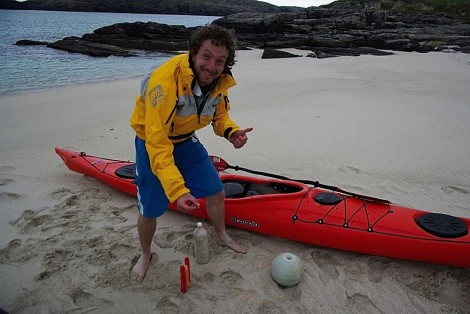
Fish Trap made from beach rubbish.
All photo courtesy of David Fairweather.
With alpine adventures under way and expedition season fast approaching, this months Coaching Dispatches looks at big waves.
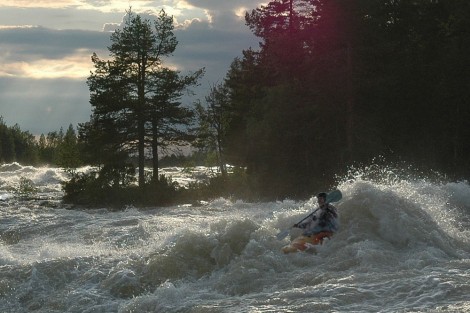
Photo: Tim Burne | Location: Sweden
Posture is the key to everything, without it we would capsize. When dealing with big waves upper and lower body separation becomes even more important. As the boat rides up and over the wave we must be ready to let the boat pitch upwards and keep our centre of gravity over the front of the boat.
When riding through a long wave train, our vision might be limited, we might only be able to see on top of the peaks. If we then want to change the way we are facing to change river position, we must think tactically about when this can effectively be done. In tight smaller wave trains, we might not be able to turn effectively in the trough of the waves because of the resistant from the peaks around us. We can’t push the boat through a wall of water. On big tall waves we might not want to travel up the wave facing sideways, in order to maintain posture and boat speed for anything unexpected behind the wave.
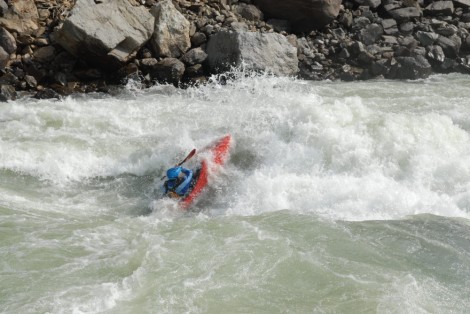
Posture is Key. Photo: Adam D | Paddler: Matt Tidy | Location: Nepal
As we see a big wave approaching, the obvious reaction is to hit the power and charge. We get that shot of adrenaline, tense up (effecting posture) and stop thinking about our strokes. As you get more used to this environment you’ll find you generally need less speed than you think and you’ll then find you have more control.
Remember you can’t take a big stroke off the top of a wave because there isn’t much water about. Two common mistakes I see regularly, is to take a stroke at the peak and the last half of the stroke just fires through the air or reaching behind a wave. In both cases we are not anticipating the change in water level through the waves. Slow, even powered strokes. This is a great time to play with changing blade pressure.
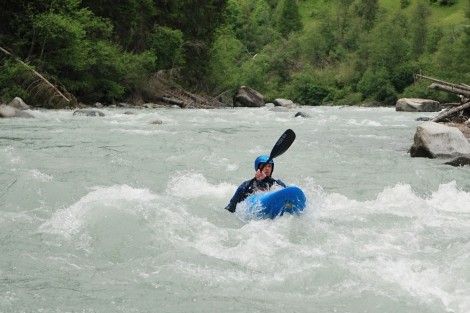
Nick applies even blade pressure as he rides over a wave in Switzerland.
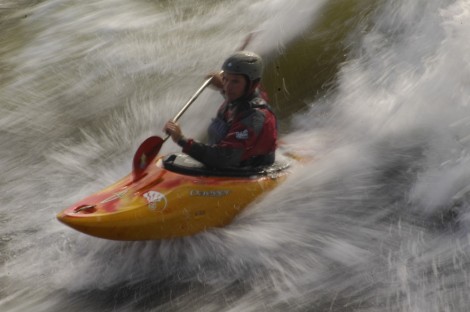
Don't forget to turn around and play on those waves! Photo: Tim Burne
Chris Eastabrook Coaching offers bespoke personal coaching covering a range of skills and mental preparation designed around your white water kayaking goals.
Roll up, roll up, hear all about it, gold for NZ and Italy, double slivers for team GB at this years throw bag olympics.

Location:
Val Sesia River Festival, Campertogno.
Competitors:
Everyone.
Rules:
- Start clipped onto your rescue harness and to a static line with everyone else.
- On the count of 3 run forwards to the line and, using an underarm throw, hit the Palm banner on the volley ball net
- Collect bag and onwards to the overarm throwing target, a lime Amp vest hanging from a tree.
- Once target hit, grab bag and forwards to the bowling arm station, thrown kneeing down behind the line and the target is the cockpit of a new Mamba.
- Giving 110% ran back to the starting line, take out 2 hand full’s of rope and again hit the target.
- With rope fully deployed, recoil using small bunny ears (totally mission critical), and throw again.
- Repack bag, bag upside down above head.
The Prizes:
Amp Vest, Luna Jacket, Palm safety slings, 18 & 12m throw bags and Palm t-shirts.
The Winners:
Sam (NZ) & Dan (GB) for the men, Frederica (I) and Lisa (GB) for the ladies.
The Serious Part.
With all that fun over (for now), there’s a serious part to this chaos. You need to practice throwing your line accurately, because when you need it, it’ll really matter. I would encourage you to get it right every time but also practice the recoiled throw.

Crazy Time Lapse Video.
Palm Throw Bag Olympics from Chris Eastabrook on Vimeo.
In Other News.
The whole Gene17 Val Sesia River festival was a complete hoot. Who doesn’t love bedrock granite? Who doesn’t like quality cheese, coffee and wine? Same time next year?
There’s another chance to win Palm goodies at the Sjoa River Festival, Norway.

Thanks to Richard Watson for the photos and time lapse.
Next weekend is the Val Selesia festival and along with fellow Palm paddler Dave Carrol, I will be running the Palm Throwbag Olympics (Thursday and Friday evenings) so I figured it would be good time to share some of the top tips I regularly teach on white water safety and rescue courses ready for the competition.
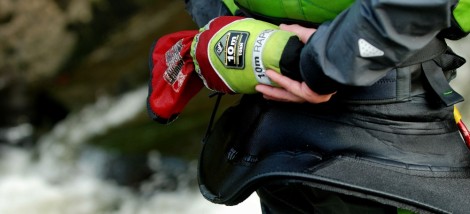
1. Plan. Using a throwbag is usually proactive, as in you have time to plan where and how you’ll be using it rather than reactive (jumping out your boat as someone swims passed?). Use this time to think about where a paddler is likely to swim, and whether there is an eddy to swing them into.
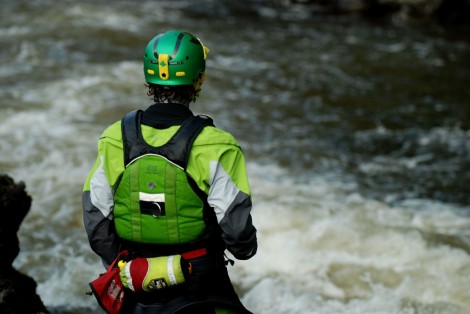
2. Throw. Too much emphasis is put on the throw itself, as long as it reaches the swimmer, no problem! Roughly I use underarm when I want accuracy, an overarm when I’m throwing down from a cliff or I want the swimmer to feel the rope hit them and a wide bowling action for distance, like putting a rope across a river.

3. Belay. Key for me is managing the forces just as the rope goes tight. The load is same for you on the bank as it is for the person in the water. It doesn’t matter how strong you are, your grip on the rope or the ground if the person in the water is tired, they won’t be able to hold on. You, as the rescuer, must anticipate the force and brake appropriately. The easiest way of doing this to move downriver and away from the river, space you planned for in step 1. It is possible to let rope out or use a body belay but again doesn’t matter how you brake someone in the water as long as you do, allowing you to rescue any sized person. The bigger they are, the stronger the water, the more braking distance need.

Next Month’s Dispatch will look at tactics for bigger water paddling as many of us head away to France and Austria for some summer sun.
Chris Eastabrook offers year round safety and rescue courses and has Palm PFDs, throwbags and other goodies available to try out on the standard and advanced courses. Click here for www.chriseastabrookcoaching.com.
The photos for this blog came from David Fairweather, check out www.davidfairweather.net for more photos and stories. Thanks Dave, Thave.
Over the past fortnight I’ve had the new Luna PFD for my students to use during their coaching sessions. The reception has been great, but don’t take my word for it!
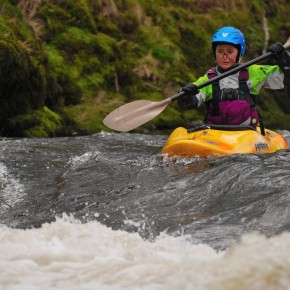
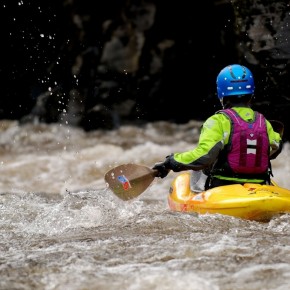
I am just starting to invest in kayaking kit and what I liked best about the Palm Luna is the front entry option (so I don’t always have to pull it over my head). This makes it easy to whip on and off without necessarily having to remove my helmet. It is kitted out with plenty of pockets and while I initially found it a tad bulky at the front when compared with what I am used to, the large padded pocket settled down with use. A piece of kit I would seriously consider investing in. Gemma, London
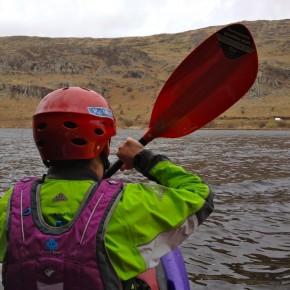
I didn’t even know they made kayaking kit for girls, until now I thought it was all unisex shapes. It’s pretty inspiring to know that companies have thought about woman in sport and it actually feels awesome to wear. Marissa, North Wales.

It’s really comfy and good because you don’t have to readjust everything each time you put it on because of the clips. I’m looking for a rescue PFD because I’m becoming a River Leader at my club and the Luna will help me carry all my kit and be confident on the river. Vicky, Birmingham. Photo is of Jess also sporting the Plum coloured Luna.
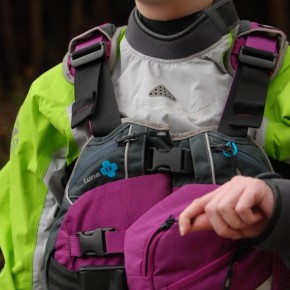
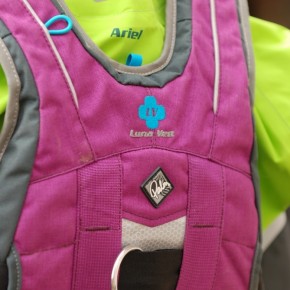
Available to try on at your nearest Palm dealer now!































